How to Create a Line Chart in Excel
In this article, you will learn about the Line Chart and how to create it in Excel.
What is a Line chart in Excel?
A line chart in Excel displays data points as markers connected by straight lines. It is commonly used to show trends over time or compare multiple data sets. For instance, we put time intervals on the left-to-right axis and things like prices and sales on the up-and-down axis. The way the line goes up or down on the graph typically tells you if your data is getting bigger or smaller.
How to make a Line chart in Excel
In this article, we will guide you through the steps to create a line chart in Excel.
Step 1: Organize your data
Before we begin creating our line chart, we need to ensure our data should be in a table format, with each column representing a different category or data point. For a line chart, you need to have at least two columns: one for the x-axis and one for the y-axis. Ensure your data is arranged logically and that all the data is entered correctly.
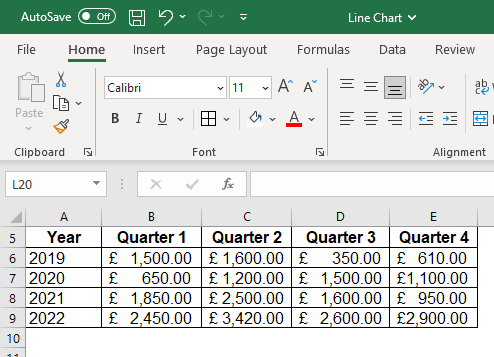
The example dataset taken is quarterly product sales data from 2019 to 2022. The objective is to determine data trends regarding products sold across different years in respective quarters. Again, in terms of data preparation, you need to ensure a clean, formatted, and consistent dataset.
Step 2: Select your data
Once our data is organized, we can select the data we want to include in our line chart. To do this, simply click and drag your mouse over the cells containing the data. If you have a large dataset, you can hold down the "Ctrl" key and select multiple data ranges.

The selected dataset will be highlighted by a border across the text for visual confirmation.
Step 3: Insert the Line chart
We can now insert a line chart into our spreadsheet with our data selected. To do this, navigate to the "Insert" tab on the Excel ribbon and select "Line Chart" from the chart options. You can choose one chart from various line chart types, including 2D and 3D line charts.
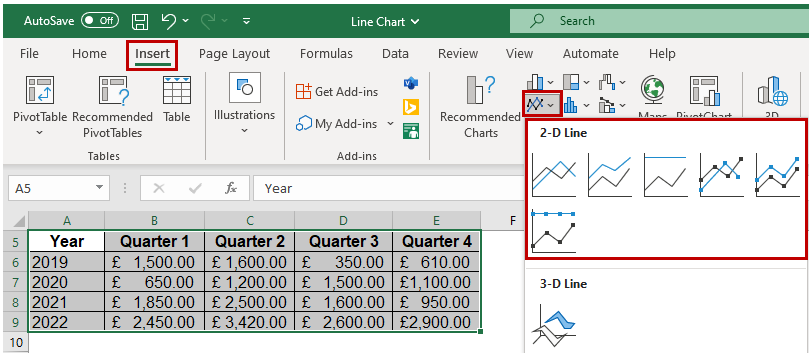
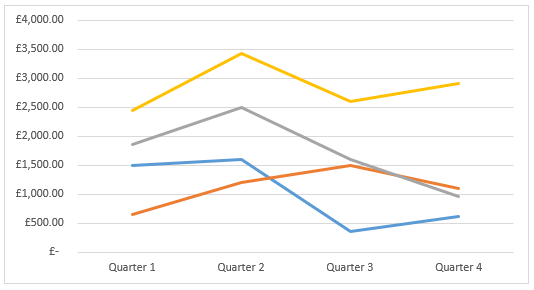
Step 4: Add a chart title and legends
You can add a “title” and a “legend” to make your line chart easy to follow and read. The title should clearly state what the chart shows, while the legend should provide information about what each line means. To add a title and legends, click on the chart to select it, then use the “Add Chart Element” followed by the “Chart Title” option in the "Chart Design" tab to add them. You can choose the Title location from the sub-menu, as shown below.
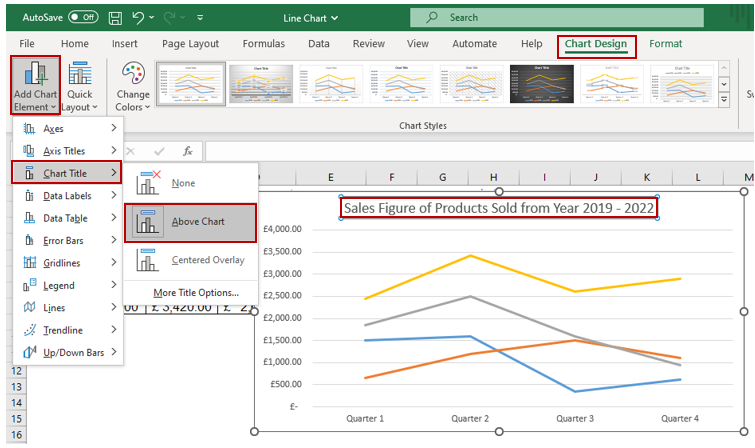
Another way to quickly access “Chart Elements” is to click on the + icon when you select the chart.

You can rename the Chart Title by clicking on the textbox for Title and editing the text directly. The “Format Chart Title” menu appears on the right side of the spreadsheet, where you can change the Chart Title's background color and set the Transparency options.

If you click on the Legends, then the “Format Legend” menu appears, which lets you define the position of legend appearance over the chart. You can also modify the text font, colors, and background color.
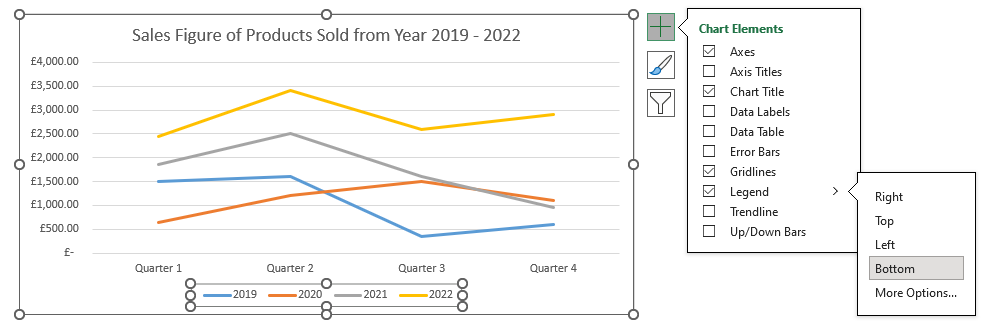
Step 5: Customize your Line chart
Once you have inserted your line chart, you can customize it to fit your needs. You can change the chart title, axis labels, and legend to provide context for your data. You can also adjust the color scheme and chart style to make your chart visually appealing.
To customize the chart, click on it to select it, then use the options in the "Chart Design" and "Format" tabs in the ribbon. Using the quick access “Chart Elements”, you can enable the “Data Labels” and choose the layout option.

You can set the color scheme using the quick access “Chart Styles” and choose a desired set of colors.
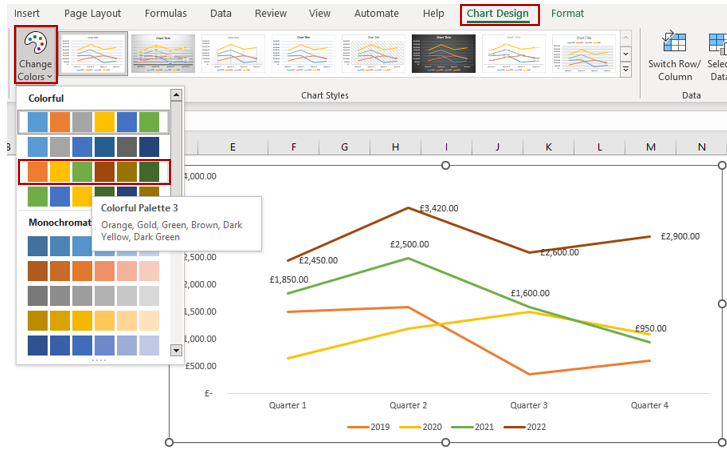
The “Format Data Series” menu appears whenever the chart series is selected. You can choose the Chart Area, Title, Legend, Plot Area, and Series from the dropdown list for customization.
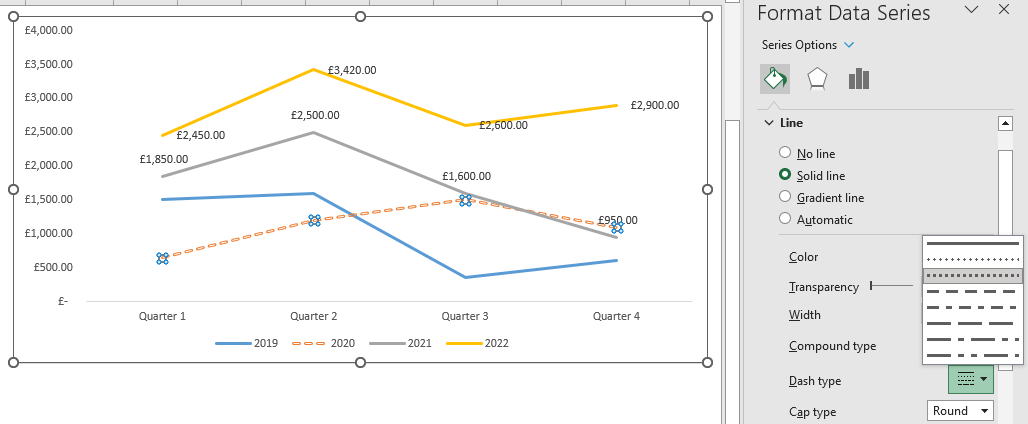
Selecting the Chart Styles
You can utilize the various chart styles present in Excel to quickly decorate your chart and give it a professional look. This is useful when you need to quickly customize your chart and give it a clean and crisp look or if you are not familiar with chart style customization.
You need to click on the “Chart Design” menu and then the dropdown button to expand the chart styles in the “Chart Style” group. Once you hover your mouse, the chart styles are applied to your existing chart for a quick preview to select and choose.

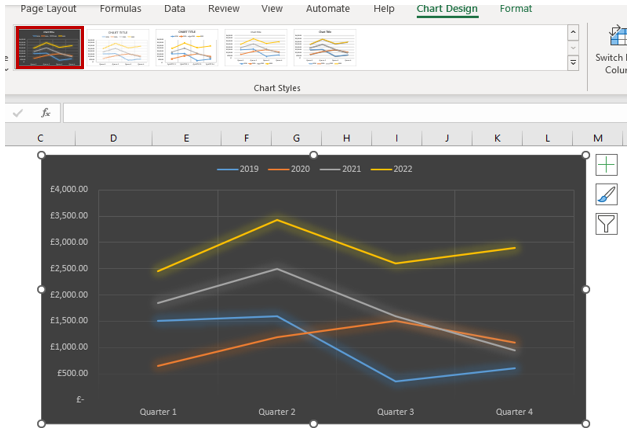
Step 6: Analyze your data
Now that you have created your line chart, you can analyze your data to gain insights and draw conclusions. Look for trends and patterns in your data and use your chart to illustrate these findings to your audience.

Looking at the plotted chart, we can quickly understand that the company consistently performed well in 2022 across all quarters. In 2019, sales figures dropped in the third quarter, contributing to lower sales revenue generated. Similarly, in 2021 the company saw a decline in sales in the third quarter, and that trend lasted in the fourth quarter.
Creating a line chart in Excel may seem daunting at first, but by following these simple steps, you can create a visually appealing and informative chart in no time. So go ahead and impress your audience with your newfound Excel skills!
When should I create a Line chart in Excel?
A line chart in Excel is typically used to show trends over time or compare multiple data sets. Here are some specific scenarios where a line chart might be helpful:
- Tracking progress over time: If you want to track changes in a metric, such as sales or website traffic, a line chart can help you visualize the trend and identify patterns.
- Comparing multiple data sets: If you have multiple data sets that you want to compare, a line chart can help you see how they relate to each other and identify any similarities or differences.
- Analyzing data with continuous values: If your data is for a certain period, such as temperature readings or stock prices, a line chart can effectively display the data and identify any trends or fluctuations.
What is a 3D line chart in Excel?
A 3D line chart is a variation of the standard line chart that displays data in a three-dimensional space. Instead of a flat, two-dimensional chart, a 3D line chart includes a third dimension representing a different variable, such as depth or volume.
In a 3D line chart, the lines are plotted on a three-dimensional coordinate system. This allows for a more complex data visualization, with the lines appearing to rise and fall in a 3D space.
However, while a 3D line chart can be visually appealing, it sometimes can be more challenging to read and interpret than a standard line chart. The additional dimension can make it harder to see the exact values of the data points and sometimes create visual distortions or misrepresentations. As a result, it's essential to use a 3D line chart judiciously and only when it adds value to data visualization.

What types of line charts are available in Excel?
There are several types of line charts available in Excel, including:
Basic Line Chart: This is the simplest type of line chart, where a line connects the data points in a single series.
Stacked Line Chart: A stacked line chart displays multiple series of data, with each line stacked on top of the previous one to show the cumulative effect of each series.
100% Stacked Line Chart: This type of chart is similar to a stacked line chart, but the lines are normalized to 100% of the total value, making it easier to compare the relative contributions of each series.
Area Chart: An area chart is similar to a basic line chart, but the area between the line and the x-axis is filled in, creating a visual representation of the magnitude of the data.
Cumulative Line Chart: A cumulative line chart shows the cumulative effect of multiple data series. Each line represents the total value of all the previous data points in the series.
Dual Axis Line Chart: This type of chart illustrates two series of data with different units of measurement, such as sales and profit margins, on a single chart. Each series is plotted on its axis to make it easier to compare the trends of each.
Each type of line chart has its advantages and disadvantages, and the choice of which one to use will depend on the specific needs of the analysis and the data to be visualized.

